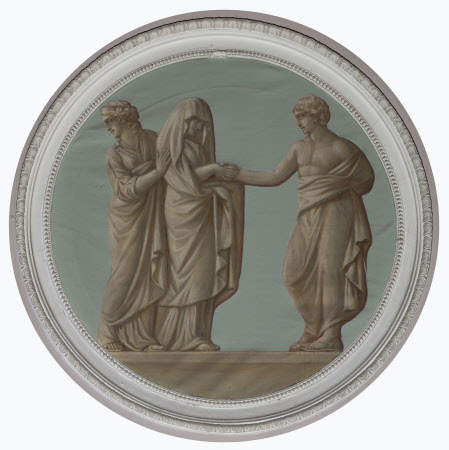A (Grecian/Roman) Wedding: introducing the Intended Bride (after Farnese antique relief) (Called 'The Marriage of Peleus and Thetis, in the presence of Juno') ('Alcestis, heavily veiled being returned from the Underworld to Admetus')
British (English) School
Category
Art / Oil paintings
Date
1759 - 1769
Materials
Oil on canvas (grisaille) (circular)
Measurements
750 mm (diameter) (E)
Order this imageCollection
Kedleston Hall, Derbyshire
NT 108793
Summary
Oil painting on canvas (grisaille) (circular), A (Grecian/Roman) Wedding: introducing the Intended Bride, British (English) School, 1759-69. The first of a sequence of four. There is The Marriage of Peleus and Thetis in the presence of Juno; almost identical composition in a scagliola by Lamberto Christiano Gori (1730 -1801) MDCCLXXIII (1773) at Ashmolean Museum, Oxford, 1991:427, bequeathed by J. A. Brister -Peleus, a Greek hero was married to Thetis, a sea-nymph and they were the parents of Achilles. Eris, the goddess of Strife/Discord throws down an apple, inscribed 'to the fairest', at their wedding feast in the presence of the gods, setting off a train of events that led to the Trojan War; or Alcestis, heavily veiled being returned from the Underworld to Admetus. (Sometimes Hercules retrieves her or Proserpina) Both are derived from Nova Nupta, in Pietro Santo Bartoli, 'Admiranda Romanarum Antiquitatum', (1693), fig. 57, from the relief 'In Aedibus Farnesianis'.
Provenance
Recorded in the Hall by 1769; bought with part of the contents of Kedleston Hall with the aid of the National Heritage Memorial Fund (NHMF) in 1986 when the house and park were given to the National Trust by Francis Curzon, 3rd Viscount Scarsdale (1924-2000)
Credit line
Kedleston Hall, The Scarsdale Collection (acquired with the help of the National Heritage Memorial Fund and transferred to The National Trust in 1987)
Marks and inscriptions
n
Makers and roles
British (English) School, artist
